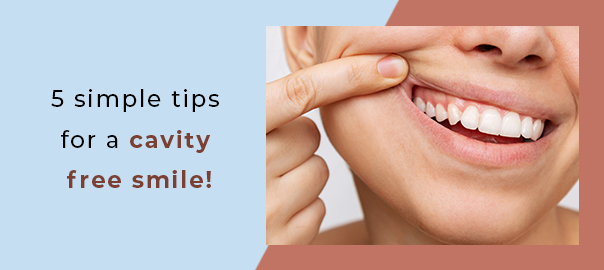
No More Gatekeeping: The Dentist Recommended 5 Simple Habits To Prevent Cavities
Table of Content
Are you someone who gets overwhelmed and scared everytime you hear the sound of a dental drill or the cry of a patient in pain waiting for his tooth to be extracted? Teeth decay, also known as dental caries or tooth decay, is the second most common infectious disease after the common cold. And if left untreated you might end up in unpleasant circumstances.
These facts aren’t here to scare you but to help you understand and overcome the perils of dental decay.
Welcome to our dental health blog, where we, the experts at Clove Dental, spill the tea. Today we are here offering 5 simple tips that do not make you feel overwhelmed or confused about oral health but rather leave you with a cavity-free smile. Say goodbye to gatekeeping and hello to a brighter, healthier, and happier smile!
What is Tooth Decay?
Dental caries, colloquially known as tooth decay, is a multifaceted process that impacts both the exterior enamel and the underlying dentin. This phenomenon stems from the oral microbiome’s interaction with dietary components. Specifically, oral bacteria flourish when exposed to carbohydrate-rich foodstuffs – ranging from sucrose-laden confections to starch-heavy grains.
Post-consumption, these nutrient particles linger on dental surfaces, undergoing bacterial fermentation. This metabolic activity yields acidic byproducts, which, in concert with oral flora, food remnants, and salivary components, engender a biofilm known as dental plaque. This adherent substance harbors acids capable of demineralizing tooth enamel, initiating localized structural breakdown.
As this erosive process persists, it manifests as carious lesions – colloquially termed cavities. These microscopic breaches in dental integrity can progress, compromising tooth structure and function if left unchecked. Thus, the trajectory from dietary choices to bacterial metabolism to enamel dissolution illustrates the intricate etiology of dental decay.
Risk Factors
Where there is a tooth, there is a potential for decay. Every surface of the tooth risks accumulation of bacteria, but the following factors lead to aggravated risk of teeth decay:
1. Location of the tooth:
In most cases, decay is most commonly seen in the back teeth, namely the molars and premolars. These teeth have a complicated anatomy, full of pits, fissures, and grooves, along with multiple roots, making cleaning difficult.
2. Type of foods and drinks:
Sticky food, such as honey, sugar, chocolates, ice cream, cake, cookies, hard candy, mints, chips, or soda, is more likely to cause decay than food that can be easily washed away by saliva.
3. Increased snacking or sipping:
This fuels mouth bacteria to produce larger amounts of acids that attack and wear down teeth, increasing the risk of tooth decay.
4. Poor oral hygiene maintenance:
Not rinsing or brushing teeth after meals and drinks can lead to plaque formation and the first signs of decay and gingivitis.
5. Malaligned or crowded teeth:
In cases of crowding, there is an increased instance of food accumulation leading to plaque formation, as the teeth alignment makes it difficult for the toothbrush to reach.
Is There a Scope of Prevention?
Even with all the risk factors complicating oral health, there is nothing that good oral and dental hygiene cannot fix. We promised you a gateway into our secrets and here we are letting you in.
5 simple things you can do to preserve your smile
1. Assess Your Cavity Risk:
Regular dental check-ups are crucial for evaluating your oral health. Biannual visits allow for timely risk assessment and implementation of preventive measures. This personalized approach enables more effective oral care strategies.
2. Master Proper Brushing Techniques:
The efficacy of brushing lies more in technique than frequency. Consult your dental professional for a personalized brushing method tailored to your specific oral health needs. Our clinic employs a hands-on educational approach for optimal results.
3. Prioritize Water Consumption:
While caffeine cravings are understandable, prolonged exposure to acidic beverages and added sugars can be detrimental. Limit consumption time and frequency, opting for water when possible. Post-sugary drink rinsing is advisable for minimizing harmful effects.
4. Embrace Flossing:
Dental surfaces require comprehensive cleaning. Flossing complements brushing by reaching areas toothbrushes can’t access. With practice, this essential habit can be seamlessly integrated into your daily routine.
5. Eliminate Tobacco Use:
Tobacco’s harmful effects extend beyond general health to oral wellness. Its use is associated with increased risks of periodontal disease, tooth loss, and oral malignancies. Cessation is vital for maintaining optimal oral health.
Some additional things you can do to level up your oral health game:
– Use a fluoride-containing mouthwash daily; they also contain antiseptic ingredients to help kill plaque-causing bacteria.
– Eat nutritious and balanced meals and limit snacking. Avoid carbohydrates, and if you consume sticky food, make sure to brush your teeth soon afterward.
– For bottle-feeding kids or infants, start brushing as soon as their first teeth appear in the oral cavity. For those before that age, make sure to wipe off the gum pads with a wet, soft cloth after feeding.
– In cases of reduced salivary production, inquire about gums or candies that help increase saliva production.
Cavities and teeth decay are so common that they generally go unnoticed and ignored by an individual because they fail to understand the consequences of ignorance; if left unattended, they lead to such severe pain that it becomes difficult to even go on with the day and many sleepless nights. With cutting-edge advanced technology available at 650+ Clove Dental clinics across India, it has become possible to detect caries at the earliest stage and provide preventive and conservative treatments. It’s never too late to care!
Leave a Reply
Leave a Reply
Explore More Similar Posts
Explore More Blogs


Leave a Reply